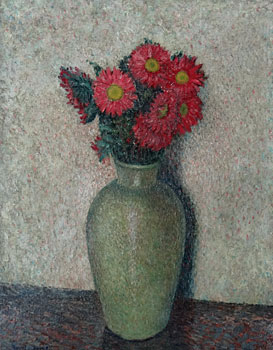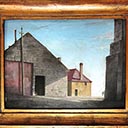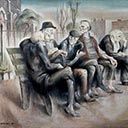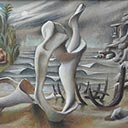Asters
45 x 35 cm
est. $12,000 - 18,000
PROVENANCE
Private Collection, Auckland Original McGregor Wright's label affixed verso
Asters is really a study of light. Even though the objects depicted - vase, flowers, table-top and wall - are rendered with a luscious impasto materiality, looking closely it is possible to see that McIntyre's real love here is for the chromatic quality of light. Notice how the shadows are made deep and dark with blue, not black; and notice too how even the dark shadow on the wall, to the right of the vase, is flecked with the same warm crimson used in the flowers. In fact the whole grey wall is speckled with coloured light - pale celadon greens, tender blues, and rose and Paris pinks - that can only have originated as reflected light, bouncing off the flowers and the vase; and to a lesser extent the table. McIntyre has carefully placed the light source behind him for this study so that the whole still life is flooded with light; and so that he can play with all its chromatic effects and create a speckled colour field rather than be drawn into the more conservative and conventional job of rendering the objects' forms through chiaroscuro.
The other noticeable and slightly discomforting aspect to the work is the almost claustrophobic treatment of space. It is as if McIntyre, in the true spirit of the post-impressionist avant-garde which he was to be deeply influenced by once he did get to Europe, wishes to shock us, at least a little. You can see that he wants to flatten the space as much as possible.
Asters was most likely painted just before McIntyre left for London in 1909 - yet it is a remarkably impressionist work at a time when there were few opportunities for artists to gain any experience of impressionism in New Zealand. McIntyre was not only lucky; he was an eager pupil. After studying at the Canterbury School of Art he shared a studio in Christchurch with Sydney Lough Thompson who had recently returned from four years studying and working in Europe; and then he was able to observe impressionism first hand, albeit the quieter English version, when twenty works by New English Art Club painters were shown at the New Zealand International Exhibition in Christchurch in 1906-1907.
Although he exhibited with the Canterbury Society of Arts from 1899 to 1910, his impressionist tendencies brought him scorn from the local critics. They called him a 'decorative' painter; and while such criticism arises from a correct observation of the flattened space of his paintings and the all-over brushwork and colour effects, it misses the mark as a judgement of his talent. These so-called decorative paintings were uncomfortable or shocking because they were moving towards a radically new way of painting: ultimately towards the non-objective art of Kandinsky and Malevich's Black Square. Rob Garrett





